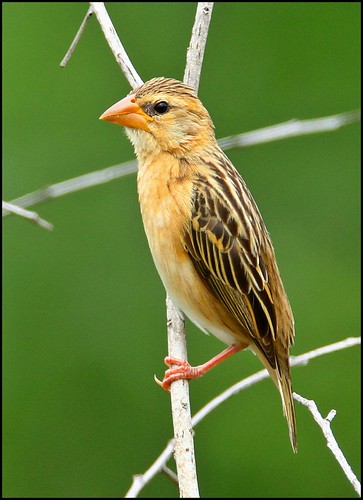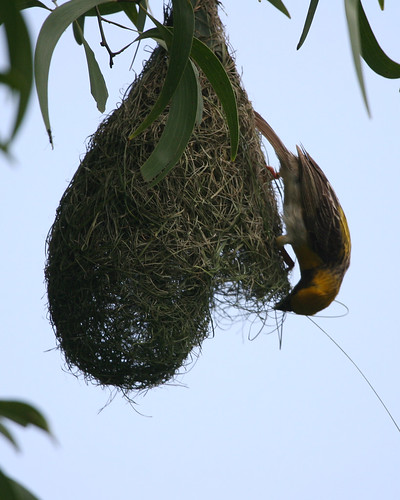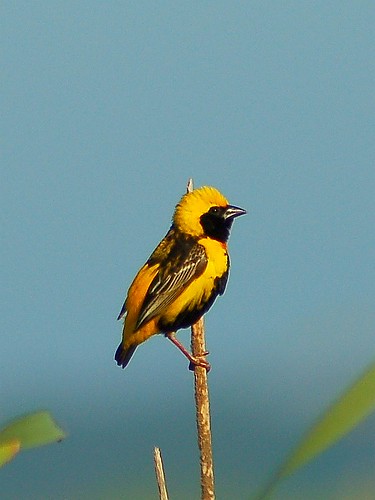
A STOMPer caught this rare sight of a weaver bird nest on a tree in front of Block 289E Bukit Batok Street 25.
The STOMPer said:
"This picture was taken at Block 289E Bukit Batok Street 25.
"It shows nests built by the weaver bird.
"This bird feeds on grass seeds and it forages in flocks.
"The males usually build the nests which have a nesting area with a long tube that leads to a side entrance.
"The tube makes it difficult for snakes to enter and devour the young birds.
"This nest can last about three months, which is the period of the breeding season."
These are nests built by the baya weaver (Ploceus philippinus), a sparrow-like bird that is widely distributed throughout India and Southeast Asia. This is a relatively common species in Singapore, and can be found in grasslands, cultivated areas, and scrub and secondary growth close to water.

Male baya weaver in breeding plumage, Sungei Buloh Wetland Reserve;
(Photo by w_yiwen)

(Photo by hiker1974)
Compared to the male, the female is much more drably coloured.
Weaver birds are well-known for their skill at nest-building; there is an excellent account on the breeding habits of the baya weaver over at this page.
The Baya Weaver's nest is an architectural feat. It hangs from a palm frond or branch and looks like an upside down flask. The general features are a central nesting area with a long tube that leads to a side entrance. This tube makes it difficult even for snakes to enter the nest. Although they look precarious, most nests are very well attached and are impossible to remove without almost destroying the nest. The nests last well through the 3-month breeding season, sometimes even up to a year. After the breeding season, other small birds may roost in the abandoned nests. The nests are made entirely out of strips of grass which the birds collect by cutting a notch in a tall grass, then stripping off a 30-60cm length.
No stalks or entire grass blades are used. The birds then use their strong beaks to weave and knot the strips of grass. A newly-made nest is green with fresh grass and turns brown as the grass dries. A bird may make up to 500 trips to complete a nest. Madoc reports that a "male" nest he examined comprised 3,437 strips of grass 4-50 cm long.
The males are promiscuous and try to attract females by building several nests halfway. These half-built "male" nests look like motorcycle helmets complete with chin strap! Lumps of dry clay may be inserted around the rim to stabilise the nest in strong winds. The male performs displays and songs on these half-built nests to attract a mate. This type of nest is also called a "cock-swing"!
A female bird first inspects the male's handiwork of a nest before signalling her approval to him. Once a female chooses to mate with him, he might finish the nest. But often, the female completes the nest. When the female lays and is preoccupied with incubating the eggs, the male abandons her and immediately uses his other half-finished nests to woo a new female. Most males mate with two females, but sometimes three. The males defend his nests from other males. Meanwhile, the female is left to incubate and raise the brood on her own. 3-4 white eggs are laid and the nestlings are fed insects.

(Photo by Lip Kee)
Like many other weaver bird species, baya weavers are known to nest in colonies.

(Photo by Ace Gautam ...)
There are several interesting accounts of baya weaver nesting behaviour over at the Bird Ecology Study Group.
Baya Weavers
Anatomy of a nest: Baya Weaver
Baya Weaver - Hornets
Baya Weaver: Nest building, hornets and poaching
Baya Weavers: Nest building and after
Sophisticated architecture of Baya Weaver's nest
Details of the Baya Weaver's nest
There is also an excellent gallery of baya weavers nesting over at this gallery by James Wong.
Besides the baya weaver, 3 non-native species of weaver have been recorded in Singapore.
The streaked weaver (Ploceus manyar), which is native to other parts of Asia, was first recorded in Lorong Halus in 1997. A second population was reported at Marina East in 2003, and breeding is known to have occurred.

Streaked weaver, Gurgaon;
(Photo by Abhishek unplugged!)
A second Asian species, the Asian golden weaver (Ploceus hypoxanthus), was recorded in 2003 at Lorong Halus, where 2 males were spotted.

Asian golden weaver, Bangkok;
(Photo by somchai@2008)
2 male individuals of the yellow-crowned bishop (Euplectes afer) spotted in a marsh in Tanah Merah in 2001 are the only records of this African species of weaver bird in Singapore.

Yellow-crowned bishop, Estarreja;
(Photo by jvverde)
The weaver birds are closely related to several families which are quite similar to one another, such as the sparrows (F. Passeridae), munias (F. Estrildidae), buntings (F. Emberizidae) and finches (F. Fringillidae). More about these in another post...